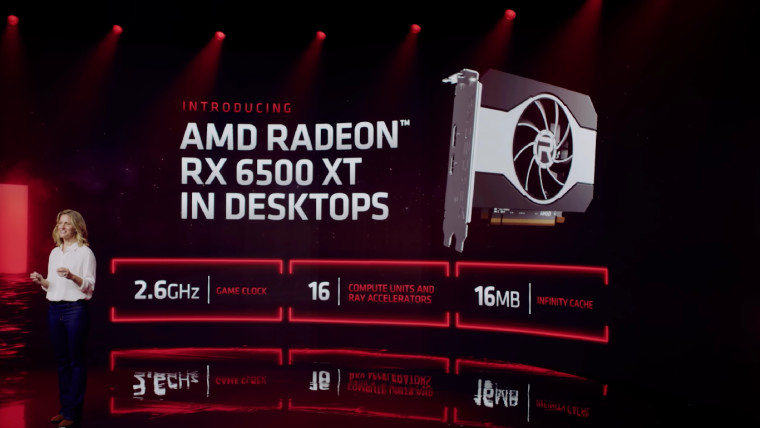
AMD recently introduced its budget graphics card offering this generation with the launch of the $199 Radeon RX 6500 XT. However, the card has generally been met with criticism from the tech media due to its several key hardware limitations making it pretty bad at AAA gaming on PCIe 3.0 or older systems, and a terrible choice for HTPC users and light streamers. That's because the Navi 24 GPU inside the RX 6500 XT is limited to just four lanes (x4) of PCIe bandwidth, and it lacks AV1 decode as well as hardware encoding features. The card also comes with just a couple of display outputs.
But why?
An AMD employee confirmed (via Phoronix forum) what many had suspected, that Navi 24 was originally designed for laptops in mind and was later re-purposed as a desktop offering.
The primary use of Navi24 will be in laptops paired with a Rembrandt APU, which has full video functionality and Gen4 PCIE.
Basically, Navi 24 will later be paired with AMD's upcoming Ryzen 6000 Rembrandt mobile APUs which will handle the decoding and encoding work. And Rembrandt will also feature PCIe 4.0 support which would have mostly alleviated the problems associated with the narrow PCIe x4 width. Though skipping on such important features was pretty short-sighted on AMD's part seeing how the card is so underwhelming as a desktop product.
Could it have been better?
However, I do believe the company could have handled the Navi 24 desktop GPU launch in a smarter way and avoided much of the flak it received. This could have been done by simply skipping the launch of the Radeon RX 6500 XT in the DIY market entirely in favor of the cut-down RX 6400 GPU. In the next couple of paragraphs, I try to reason why.
The RX 6400, which has been reserved for OEMs only, comes with four Compute Units (CUs) fewer than the 6500 XT, packing 12CUs or 768 Stream Processors. In terms of clocks too, it is specced much lower with a boost speed of 2,321 MHz compared to the 6500 XT's 2,815MHz. So summing it up, overall we are looking at a total single-precision or FP32 compute performance of ~3.57 TFLOPS for the Radeon RX 6400, which is nearly 40% lower than the full Navi 24-based RX 6500 XT's.
If you are scratching your head and wondering how releasing a slower part could have helped AMD, the answer is simple. Due to the PCIe x4 limitation mentioned earlier, the full Navi 24 chip in the form of the 6500 XT is already bottlenecked on any system that isn't PCIe 4.0 or higher. The card loses close to 30% of its performance in VRAM intense games like DOOM Eternal on a PCIe 3.0 platform, and the loss would be even higher on something even older like PCIe Gen2.
Here are a few instances where the lack of PCIe throughput really hammers the performance of the 6500 XT:
 |
 |
In contrast, the much slower RX 6400 wouldn't have hit these limitations anywhere nearly as easily or as often and hence, would have been a much more consistent performer across PCIe 3.0 and 4.0 platforms.
The RX 6400 would likely perform like Nvidia's popular Pascal-based GTX 1050 Ti, but it would have been a decent upgrade over previous-gen entry-level cards like GT 1030 or RX 550 or something even older. The RX 6400 has a 53W TDP so it would have been a simple plug-and-play installation too not needing the extra power connectors.
All this would have made the RX 6400 a better recommendation in my opinion compared to the far more inconsistent RX 6500 XT. Of course, this is all assuming AMD will have launched the 6400 for a price of around ~$109 providing a similar value (performance/$) to the corresponding $199 RX 6500 XT.
And although the RX 6400 wouldn't have solved the hardware encoder issue inherent in the Navi 24 chip, buyers at this price point may have been willing to overlook the issue as the last-gen GT 1030 also packed no NVENC encoder but was still a very popular card among the masses.
Would a $109 RX 6400 made sense from AMD's business standpoint?
The answer to this would depend a lot on the yields of the 6nm, 107 mm² Navi 24 dies. But in general, unlike the 107W 6500XT, a 53W GPU like the RX 6400 could get away with much more lightly built heatsinks and single-fan solutions. There's no PCIe connector either leading to some additional cost savings there.
As for the RX 6500 XT, frankly, the $199 Navi 24 card shouldn't have launched for desktops at all, not in the current market at least where PCIe 3.0 platforms are still so common. Even AMD's own current budget chipset in the mainstream segment, the A520, lacks PCI 4.0 support.
Images via TechPowerUp
Edit: Replaced Shadow of the Tomb Raider with Deathloop image


_small.jpg)















9 Comments - Add comment